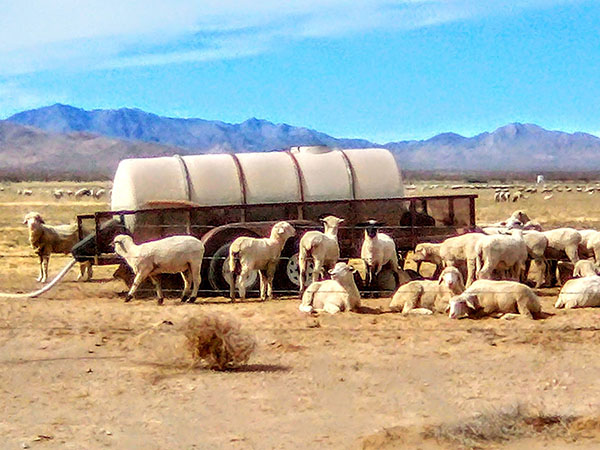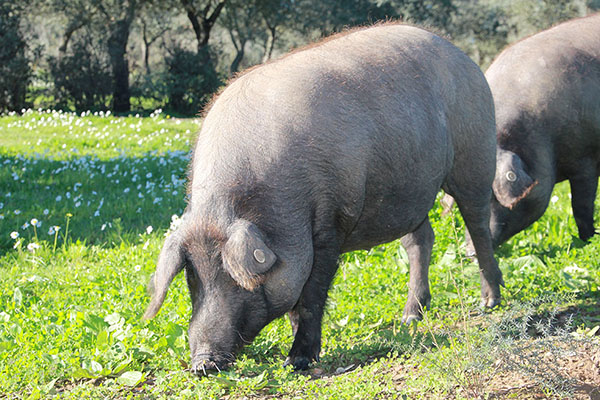Meats and Sausages
Kosher Sausages
The manufacture of Kosher sausages follows the same processing steps that are employed for making other sausage types. Strictly kosher sausage is made by firms that specialize in this type of production, as the meats must come from animals that have been slaughtered according to Jewish rules. The sausage recipes in this book are “kosher style” rather than strictly kosher products in that only certain kinds of meat are used.
What must be noted is that if a food establishment caters to Jewish clientele, it is not sufficient to buy meat that conforms to the Jewish set of rules that deal with permitted foods. The meat must come from animals that were slaughtered according to Kosher slaughtering rules (Shechita), which specify in detail how it must be done. Needless to say, only certified Jewish butchers would be familiar with the procedure.
Meat Selection
The meat selection, selection of casings, and choice of ingredients must conform to the requirements of Kashrut - a set of dietary laws dealing with the foods that Jews are permitted to eat and how those foods must be prepared according to Jewish law
- You may eat any animal that has a split hoof and chews cud: the cow, the sheep, the goat, the deer, the antelope. The camel, rabbit, and coney can not be eaten. Pork is not permitted.
- Of all the creatures living in the water, you may eat any that have fins and scales. That means no eels, oysters, or lobsters.
- You may eat all clean birds: chicken, poultry. Eating birds of prey, such as eagles, falcons, or nighthawks, is not permitted.
- Consuming blood is forbidden.
- Meat and milk (or derivatives) may not be mixed in the sense that meat and dairy products are not served at the same meal, served or cooked in the same utensils, or stored together.
Pork is not permitted, and that includes pork fat, which is normally added to venison, poultry, or fish sausages. However, pork fat may be replaced with:
- Beef, mutton or chicken fat.
- Vegetable oils.
Since pork is not permitted, beef becomes the material of choice; it has great water-holding properties and binds meat and ingredients well together. Its meat contains a lot of myoglobin and develops a strong red color when treated with sodium nitrite.
Fat Selection
Chicken fat tastes good; the only problem is that it melts at room temperature, and the sausage may end up with pockets of melted fat inside. An old remedy is to massage the sausage with fingers during cooling occasionally. Beef fat is not the greatest choice, however, it is acceptable. Avoid adding lamb or venison fat, as they don’t taste right.
Edible Oils
Edible oils are derived from fruits, vegetables, plants, flowers, or nuts and are processed by pressing or refining. Refined oils undergo a separate process to remove any impurities before they reach your grocer’s shelves, so they may need to be Kosher certified. Pressed oils are usually done cold, then filtered, which makes the process simple as they are made with one single ingredient. The best example is extra virgin olive oil, which can be added without breaking Kosher law. Other examples are pistachio oil, coconut oil, and avocado oil.
Vegetable fats melt at lower temperatures than meat fats, and they are liquid at processing temperatures. This may cause fat separation during processing and cooking, with fat pockets as a result. The best way to immobilize oil is to hide it inside a soy protein /oil/water emulsion or mix 2 parts of flour with 1 part of olive oil.
An emulsified olive oil at about 10%. Flax oil, sunflower oil, or a mixture of both can also be used at 6% or less; otherwise, there will be a noticeable change in flavor. Adding oils will lighten up the sausage. Emulsifying olive oil with soy protein isolate is a great idea as it helps to hold the sausage together and increases its protein content. Sausages made with oil are lighter in color than those made with solid fat.
Adding vegetable oil is a good choice, and as long as no more than 25% is added, the sausage will be of acceptable quality. Mixing flour and vegetable oil, especially in a 1:8 ratio, creates a substance called "cloud dough", which can be included. Flour and oil are commonly mixed together to create a roux, which is a basic ingredient for sauces and gravies.
Additives
Soy protein concentrate (SPC) or isolate (SPI) creates great emulsions when blended with oil and water.
Gums (hydrocolloids) can bind huge amounts of water, making sausage moister. Konjac flour, carrageenan, and microcrystalline cellulose are of plant origin, so their use should not conflict with the rules of Kosher law. Xanthan gum is made by using bacteria to ferment sugars, which should also be fine.
Gelatin can be problematic as it is made from animal collagen. If made from pork skins, it does not conform to the requirements of Kosher law, however, gelatin that is produced from fish or chicken is allowed.
Casings
Pig casings are not allowed, however, there is no shortage of beef, sheep, or synthetic casings that can be used. Not forgetting banana and grape leaves, corn husks or cellophane film.
Kosher Sausages
There are thousands of sausage recipes that can be modified and converted to Kosher sausages as long as they conform to the requirements of Jewish rules and tradition. The manufacturing process will basically remain the same. In most cases, beef, mutton, chicken, and fish will be the material of choice. It is logical to assume that a person of Jewish ancestry will be interested in making Kosher sausages, and he/she will already be familiar with the Kosher code. Besides, the rabbi can be consulted with any further questions.
Passover. During Passover time, which lasts seven days, the Kosher rules are much stricter. Some foods are off the table, although they can be consumed before and after Passover.
Passover Rules. Five kinds of grains are prohibited: wheat, rye, barley, oats, and spelt. These grains begin to ferment and rise when they come into contact with water for 18 minutes. In Hebrew, that rising grain is called chametz. The Bible bans it during Passover as a reminder that when the Israelites fled Egypt, they left with unleavened (unrisen) dough in their packs. Unleavened bread is a flatbread, often resembling a cracker; the best example is matzah, also known as matzo. So, these grains can be used to make matzo and unleavened bread, as long as the baking process is under 18 minutes.
Blood sausages
As consumption of blood is prohibited, regardless of which animal it comes from. Blood sausages usually include a filler material, and most countries have similar sausages made with the same processing steps but called “white blood sausage.” It sounds illogical; however, it is a fact: Boudin Blanc (France), Morcilla Blanca (Spain), White Pudding (UK).
LIver sausages
The liver must obviously come from a Kosher animal species. As soon as you purchase fresh liver, you should drain the excess blood from the packaging. Do not allow the liver to sit in its own blood for more than 24 hours.
Koshering livers. The liver contains a lot of blood, so it is subjected to extra processing to remove it.
Beef or calf livers. After the fats are removed, the liver can be sliced, or deep crisscross cuts should be made horizontally and vertically in the liver.
Chicken livers. These are small and do not need to be cut.
- Wash livers well after cutting them.
- Salt the livers on all sides. This will bring out the blood and moisture.
- Place beef and veal livers with cuts facing down on the broiler screen to facilitate blood dripping. Lay chicken livers on the screen. If the broiler or heating device has only fire on the bottom, the livers should be turned over halfway through the process. They need to be broiled at least halfway.
- When done, the livers must be rinsed three times in cold water.
Head cheeses and meat jellies
These products can really shine when well made, being Kosher at the same time. The definition of a “head cheese” does not really apply here, as traditionally made head cheeses were made from pork head meat, but can be produced from any meat rich in connective tissue. Such a product becomes a sausage when stuffed into a casing or a meat jelly when solidified in aspic (jelly) in a bowl.
Chicken gelatin. Chicken and fish look extremely attractive and taste wonderful when added to the natural clarified stock. It is easier to produce natural chicken gelatin when chicken claws are added to the meat broth. Concentrated chicken broth takes the first place in nutritional value compared with broths from other meats, as it has a pleasant flavor. Rapid-boiling meat parts will produce a cloudy stock that will be very hard to filter out.
Fish sausages
Kosher fish include cod, flounder, haddock, halibut, herring, mackerel, pickerel, pike, salmon, trout, and whitefish.
Non-kosher fish include swordfish, shark, eel, octopus, and skate, as well as all shellfish, clams, crabs, lobster, oyster, and shrimp.
Strong>Fish gelatin Fish gelatin (aspic) can be produced by simmering fish parts rich in collagen, such as skin, bone, and fins. After filleting the fish, the rest of the body, with the head included, is added to the pot.
Poultry sausages
Chicken sausages are just waiting to be converted into Kosher sausages by replacing pork fat with olive oil.
Kosher smoked sausages
Any sausage can become a smoked sausage by applying smoke.
Kosher Sausage Recipes
The following sausages might be considered Kosher, given that they are not made with pork meat. All detailed recipes are listed in the book "1001 Greatest Sausage Recipes" by Stanley Marianski; however, many of them are available on our website in Recipes Section Sausage Recipes
- Alheira de Mirandela - fresh sausage, smoked, beef, veal, chicken, bread - Portugal
- Beef Sausage - fresh, beef - USA
- Beef Ham Sausage (Kiełbasa szynkowa wołowa) - cooked sausage, smoked, beef - Poland
- Beef Sausage-Polish (Kiełbasa wołowa krajana pieczona) - baked, smoked, beef - Poland
- Beer Sausage with Goose Meat(Kiełbasa piwna z gęsiną parzona podsuszana - cooked, smoked, goose meat - Poland
- Bełzka (Kiełbasa bełzka parzona podsuszana) - cooked, smoked, beef - Poland
- Bialostocka with Goose Fat (Kiełbasa białostocka parzona podsuszana z gęsim tłuszczem) - cooked, smoked, goose, beef - Poland
- Bieszczadzka (Kiełbasa bieszczadzka parzona) - cooked, smoked, beef - Poland
- Belutak - fermented, buffalo/beef - Brunei
- Cârnați de Pleșcoi - cooked, smoked, sheep, beef - Romania
- Chicken Apple - fresh, chicken thighs - USA
- Chicken Sausage - Indian - cooked, smoked, chicken breast - India
- Chicken Sausage - cooked, smoked, chicken - General
- Chicken Sausage with Cheese & Onion - cooked, chicken, cheese - USA
- Curry Chicken - fresh, chicken - Thailand
- Currywurst - cooked, any Kosher meat with curry ketchup - Germany
- Droë Wors (Dry Sausage) - fermented, beef - South Africa
- Fish Links - fresh, fish - USA
- Fish Sausage - English - fresh, fish - UK
- Fish Sausage with Oil - cooked, fish - USA
- Fish Sausage with Tomato Puree - fresh, fish - USA
- Gåsleverkorv (Goose Liver Sausage) - cooked, goose liver, veal liver - Germany
- Glamorgan - cooked, no meat, bread, cheese, leeks, onions - Welsh/UK
- Greek Sausage - Traditional - fresh, lamb - Greece
- Goose or Duck Head Cheese - cooked, goose, calf/beef - Germany
- Gornooryahovski Sudzhuk - fermented, beef - Bulgaria
- Kalbsbratwurst (Veal Bratwurst) - cooked, all veal meat and fat - Germany
- Karnatzlach - fresh, beef or lamb - Romania
- Kosher Bologna - baked, smoked, beef, veal - USA
- Kosher Liver Sausage - veal liver, beef - USA
- Kosher Salami - cooked, beef - USA
- Lamb Sausage - Welsh - fresh, lamb, leeks, rusk - UK
- Lebanon Bologna- fermented, beef - USA
- Lifrapylsa - cooked, liver, sheep liver, sheep fat - Ireland
- Makanek - fresh, beef, lamb - Lebanon
- Maranho de Serta - cooked, goat meat, rice - Portugal
- Mediterranean Chicken Sausage - fresh, chicken meat, fat, and skins - Mediterranean
- Merguez - fresh, lamb - North Africa
- Merguez - Dry - fermented, lamb - North Africa
- Mombar Mahshy - cooked, beef, rice, flour - Egypt
- Mondejo or Mondeju - cooked, sheep, leeks, onions - Spain
- Ossenworst (Ox Sausage) - fermented, beef - Netherlands
- Poultry Bouillon Head Cheese/Gelatine - cooked, chicken, beef bouillon - Germany
- Putenleberwurst (Turkey Liver Sausage) - cooked, turkey liver, turkey meat - Germany
- Rindswurst(Beef Sausage) - cooked, smoked, beef - Germany
- Salami - All Beef - fermented, beef - USA
- Salami - Kosher - fermented, beef - USA
- Scotch Pudding - cooked, beef suet, oatmeal - Scotland/UK
- Scotch White Pudding - cooked, beef, oatmeal, onions, farina - Scotland/UK
- Scotch White Pudding with Leeks - cooked, beef suet, oatmeal, leeks - Scotland/UK
- Sheftalia - fresh, lamb, beef - Cyprus
- Sucuk-Traditional - fermented, beef/lamb - Turkey
- White Pudding with Oatmeal - cooked, beef suet, oatmeal - UK
Alheira de Mirandela - Portuguese sausage carries Jewish roots and a wonderful history that goes back to 1497. In addition, it has been awarded the prestigious PGI 2016 European certificate.
Karnatzlach - Jewish sausage of Romanian origin, once very popular in Lower East Side of Manhattan in New York.
Modifying Recipes
The easiest to modify recipes are those that include filler materials such as rice, groats, bread, rusk, onions, leeks, flour, and potatoes, as they contain less pork. Many English sausages fit into this group, as well as Cajun sausages from American Louisiana. There are many potato sausages, which, in addition to potatoes, usually include pork and beef. Removing pork meat and fat from the recipe by either increasing the amount of beef or adding chicken will produce a Kosher sausage. Pork fat can be substituted with beef suet, chicken fat, or olive oil. There are many beef sausages made with beef and 10% pork hard fat trimmings - the fat can be substituted with olive oil, and the sausage mass stuffed in beef casings.
The most popular sausage in Berlin “Currywurst” can be converted into Kosher sausage without any modification because Currywurst sausage is defined not by the ingredients which are inside, but by the addition of curry ketchup during serving. This means that one can choose bratwurst, bockwurst or any sausage like Polish smoked sausage, or pure beef or chicken sausage and as long as it is served with “curry flavored ketchup” it qualifies to be called Currywurst Kosher.



















